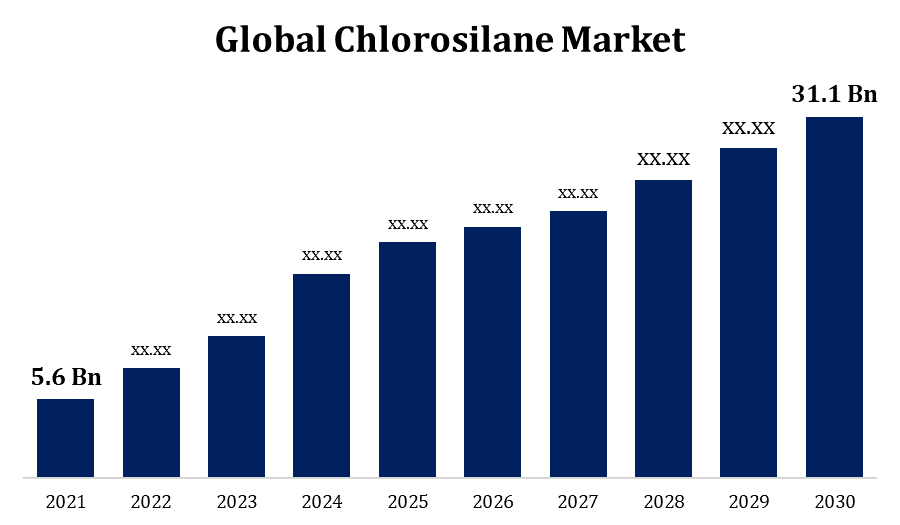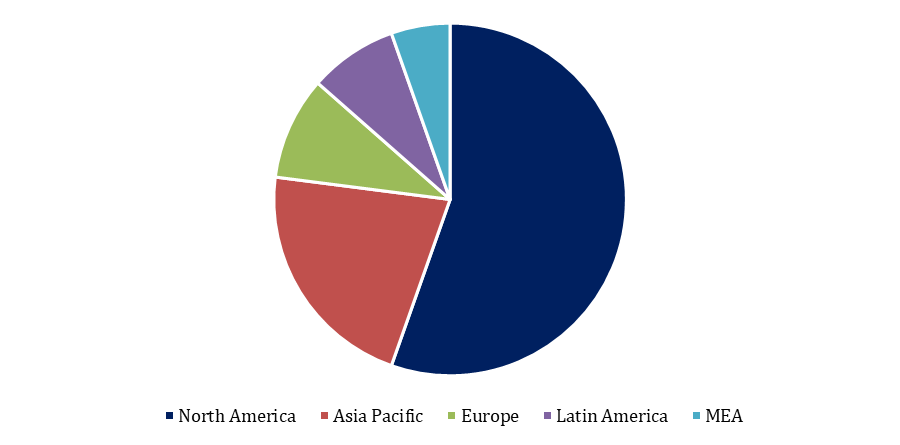Global Chlorosilane Market Size, Share, and COVID-19 Impact Analysis, By Product (Methylchlorosilane, Tetrachlorosilane, Trichlorosilane, and Dimethylchlorosilane), and By Region (North America, Europe, Asia-Pacific, Latin America, Middle East, and Africa), Analysis and Forecast 2021 - 2030
Industry: Chemicals & MaterialsGlobal Chlorosilane Market Insights Forecasts to 2030
- The global Chlorosilane market was valued at USD 5.6 billion in 2021.
- The market is growing at a CAGR of 21% from 2021 to 2030
- The global Chlorosilane market is expected to reach USD 31.1 billion by 2030
- North America is expected to grow the fastest during the forecast period
The global chlorosilane market is expected to reach USD 31.1 billion by 2030, at a CAGR of 21% during the forecast period 2021 to 2030. The chlorosilane market has been growing owing to the increasing supply of solar generation plants around developing regions. Moreover, increasing concerns linked with global warming create a huge demand for clean energy initiatives, that boost the expansion of the market.

Get more details on this report -
Market Overview:
A class of reactive, chlorine-containing chemical compounds known as chlorosilanes are linked to silane and employed in various chemical reactions. Due to their lower toxicity, chlorosilane analogs are frequently used in consumer-marketed sealants and adhesives and building blocks for medical-grade silicone. Growth in consumer awareness of the negative consequences of using various conventional energy sources, such as coal and natural gas, including higher greenhouse gas emissions. Global warming has increased as a result, and consumers now favor renewable energy sources like solar energy more than before. Further, it is anticipated that future demand for and production of solar panels and solar modules will rise due to rising carbon dioxide emissions from using various fuels in the recent past. Additionally, several drawbacks, including higher electricity bills, power outages, and low financing costs linked to the use of electricity produced using conventional energy sources, will encourage consumers to use solar energy in the residential sector, supporting the growth of the chlorosilane market for solar grade silicone. Furthermore, during the forecast period, the demand for chlorosilanes for solar-grade silicon applications in the region should rise due to clean energy targets in the corporate and industrial sectors combined with manufacturers' increasing efforts to achieve a higher level of sustainability in their manufacturing operations.
The rising demand for solar energy has increased market demand. Increased environmental deterioration, government tax breaks and incentives to install solar panels, and other factors are driving the growth of the solar energy sector. The decreased water footprint of these solar energy systems has raised the demand for them in the power production industry. The demand for solar cells has grown significantly due to an increase in rooftop and architectural installations, which positively impacts market statistics. The need for solar power towers and parabolic troughs in electricity production is anticipated to increase.
Global Chlorosilane Market Report Coverage
| Report Coverage | Details |
|---|---|
| Base Year: | 2021 |
| Market Size in 2021: | USD 5.6 Billion |
| Forecast Period: | 2021 - 2030 |
| Forecast Period CAGR 2021 - 2030 : | 21% |
| 2030 Value Projection: | USD 31.1 Billion |
| Historical Data for: | 2017 - 2020 |
| No. of Pages: | 198 |
| Tables, Charts & Figures: | 117 |
| Segments covered: | By Product,By Region |
| Companies covered:: | American Elements, Wynca Group, SIAD Spa, Evonik Industries, Gelesa Inc., Wacker Chemie AG, Dow Inc., Linde AG, OCI Company Ltd., Mitsubishi Polycrystalline Silicon America Corporation, SIAD S.p.A., Tokuyama Chemicals (Zhejiang) Co., Ltd. |
| Pitfalls & Challenges: | COVID-19 Empact, Challenge, Future, Growth, & Analysis |
Get more details on this report -
Report Coverage
This research report on chlorosilane categorizes the market for chlorosilane based on various segments and regions, forecasts revenue growth, and analyzes trends in each submarkets. The report analyses the key growth drivers, opportunities, and challenges influencing the chlorosilane market. Recent market developments and competitive strategies such as expansion, product launch and development, partnership, merger, and acquisition have been included to draw the competitive landscape in the market. The report strategically identifies and profiles the key market players and analyses their core competencies in each sub-segment of the chlorosilane market.
Segmentation Analysis
- In 2021, the dimethylchlorosilanes segment dominated the market with the largest market share of 32% and market revenue of 1.79 billion.
Based on the product, the Chlorosilane market is categorized into methylchlorosilane, tetrachlorosilane, Chlorosilane, and dimethylchlorosilane. In 2021, the dimethylchlorosilane segment dominated the market with the largest market share of 32% and market revenue of 1.79 billion. The segment is fueled owing to the virtue of increasing preference among manufacturers of solar-grade silicone. Also, the increasing demand for direct synthesis reactions to produce solar-grade silicon boosts the market. A direct synthesis reaction takes place when silicon power and methyl chloride gas are combined. This reaction produces a mixture of different liquid silicones, which are subsequently distinguished using distillation. Dimethylchlorosilane is one of a variety of liquid silicones that are made on a big scale. During the forecast period, there is projected to be an increase in demand for dimethylchlorosilane to generate solar-grade silicon due to the growing usage of solar energy in various residential and commercial grid projects. Large-scale network grids are being installed by businesses to capture solar energy and convert it into electricity to supply power to numerous residential regions.
Regional Segment Analysis of the Chlorosilane Market
- North America (U.S., Canada, Mexico)
- Europe (Germany, France, U.K., Italy, Spain, Rest of Europe)
- Asia-Pacific (China, Japan, India, Rest of APAC)
- South America (Brazil and the Rest of South America)
- The Middle East and Africa (UAE, South Africa, Rest of MEA)

Get more details on this report -
North America emerged as the largest market for the global Chlorosilane market, with a market share of around 31% and 1.73 billion of the market revenue in 2021.
- In 2021, North America emerged as the largest market for the global Chlorosilane market, with a market share of around 31% and 1.73 billion of the market revenue. The market for Chlorosilane in the North American region has been expanding because solar cell makers are working harder to improve the region's solar photovoltaic cell efficiency. Over the forecast period, it is anticipated that rising solar photovoltaic installations in the region, along with intensive research and development efforts being made by solar system manufacturers to bring technological advancements to the current design and energy-generating capacity of solar photovoltaic cells, will create more growth opportunities for regional market expansion. The U.S. government's growing encouragement of the usage of solar systems through tax credits, loans, and subsidies should further strengthen the industrial landscape. The U.S. government has implemented tax benefit policies to encourage the use of solar systems, which in turn has increased the demand for chlorosilanes for solar-grade silicone application in the area. These policies include the Renewable Electricity Production Tax Credit (PTC), Investment Tax Credit (ITC), Residential Energy Credit, and the Modified Accelerated Cost-Recovery System (MACRS).
- The Asia-Pacific market is expected to grow at the fastest CAGR over the forecast period, owing to the substantial development in the electronics industry. In Japan, China and India, the electronics industry is proliferating along with the increase in consumer electronics demand. The largest producer and user of chlorosilane was Japan. The regional business environment will be fueled by the presence of numerous well-established players in the solar industry with their fully integrated business operations in the nation to ensure an efficient supply chain and cost savings associated with the procurement of raw materials and logistics. Additionally, the Japanese government amended the Renewable Energy Act in 2020, introducing a FIP in place of a FIT for specific types of renewable power projects. The implementation of large-scale solar and wind energy projects is projected to be greatly aided by this rule, which also helps the country's market expansion. The solar industry will see more foreign direct investment, which will boost regional market income.
Competitive Analysis:
The report offers the appropriate analysis of the key organizations/companies involved within the global Chlorosilane market along with a comparative evaluation primarily based on their product offering, business overviews, geographic presence, enterprise strategies, segment market share, and SWOT analysis. The report also provides an elaborative analysis focusing on the current news and developments of the companies, which includes product development, innovations, joint ventures, partnerships, mergers & acquisitions, strategic alliances, and others. This allows for the evaluation of the overall competition within the market.
List of Key Market Players:
- American Elements
- Wynca Group
- SIAD Spa
- Evonik Industries
- Gelesa Inc.
- Wacker Chemie AG
- Dow Inc.
- Linde AG
- OCI Company Ltd.
- Mitsubishi Polycrystalline Silicon America Corporation
- SIAD S.p.A.
- Tokuyama Chemicals (Zhejiang) Co., Ltd.
Key Target Audience
- Market Players
- Investors
- End-users
- Government Authorities
- Consulting And Research Firm
- Venture capitalists
- Third-party knowledge providers
- Value-Added Resellers (VARs)
Recent Development
- In July 2021, Evonik introduced Siridion®, a brand-new, high-performance material for batteries. Chemical companies like Evonik are being driven to create more sophisticated materials by the growing use of lithium-ion batteries due to their effectiveness in solar systems.
- In April 2020, The Japanese company Mitsubishi Chemical buys Gelest Inc. (US). With this transaction, MCC's operational resources and client network will be merged with Gelest's outstanding research, development, and production capabilities.
Market Segment
This study forecasts revenue at global, regional, and country levels from 2021 to 2030. Spherical Insights has segmented the global Chlorosilane market based on the below-mentioned segments:
Chlorosilane Market, By Product
- Methylchlorosilane
- Tetrachlorosilane
- Chlorosilane,
- Dimethylchlorosilane
Chlorosilane Market, Regional Analysis
- North America
- US
- Canada
- Mexico
- Europe
- Germany
- Uk
- France
- Italy
- Spain
- Russia
- Rest of Europe
- Asia Pacific
- China
- Japan
- India
- South Korea
- Australia
- Rest of Asia Pacific
- South America
- Brazil
- Argentina
- Rest of South America
- Middle East & Africa
- UAE
- Saudi Arabia
- Qatar
- South Africa
- Rest of Middle East & Africa
Frequently Asked Questions (FAQ)
-
What is the market size of the global chlorosilane market?As per Spherical Insights, the size of the chlorosilane market was valued at USD 5.6 billion in 2021 to USD 31.1 billion by 2030.
-
What is the market growth rate of the global chlorosilane market?The global chlorosilane market is growing at a CAGR of 21% during the forecast period 2021-2030.
-
Which region dominates the global chlorosilane market?North America emerged as the largest market for chlorosilane.
-
What is the significant driving factor for the global chlorosilane market?The increasing number of solar power generation plants across developed economies will influence the market's growth.
-
Which factor is limiting the growth of the global chlorosilane market?Fluctuation in product prices could hamper market growth.
-
Who are the key players in the global chlorosilane market?Key players in the chlorosilane market are American Elements, Wynca Group, SIAD Spa, Evonik Industries, Gelesa Inc., Wacker Chemie AG, Dow Inc., Linde AG, OCI Company Ltd., Mitsubishi Polycrystalline Silicon America Corporation, SIAD S.p.A., and Tokuyama Chemicals (Zhejiang) Co., Ltd.
Need help to buy this report?